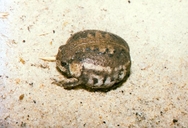|
Breviceps rosei Power, 1926
Rose's Rain Frog | family: Brevicipitidae genus: Breviceps |
| Species Description: Power, J. H. (1926). A monographic revision of the genus Breviceps, with distribution records and descriptions of new species. Annals of the South African Museum 20, 451–471. | |
|
Etymology: Breviceps rosei was named after the naturalist and dentist Walter Rose (Channing 2001). |
|
 © 2011 Martin Pickersgill (1 of 2) |
|
|
|
Description DIAGNOSIS: Breviceps rosei is smaller with a smoother, more slender body than B. gibbosus; it also has a longer snout. The angle of B. gibbosus’s metatarsal tubercle is different, and the respective pelvic arch dimensions of both species differ (Power 1926). Breviceps gibbosus also has a densely granular belly that lacks the ventral smoothness of B. rosei. Breviceps sylvestris has dorsal paravertebral ridges that are not found in B. rosei. On their feet, B. rosei does not have the fleshy webbing of B. macrops. It is deficient in a visible tympanum seen in B. verrucosus, B. poweri, and B. acutirostris. It has singular tubercles on its fore-digits unlike the double tubercles observed in B. namaquensis. Breviceps rosei also has an outer toe as long as it is wide, while B. poweri has a minute outer toe (Channing 2001). COLORATION: In life, B. rosei is characterized by its dark color with vague brown markings on its head. It has brown patches on its forehead between its eyes and on the side of its head behind its eyes. On the ventral surface, its sides and belly are whitish, speckled with black. Wavy black lines streak the submental region and chest (Power 1926). VARIATION: Occasionally, a thin stripe is present along the vertebrae with a perpendicular line joining the two hindlimbs through the vent. This stripe often appears jagged, with many gaps or branches. Male throats are slightly granular and darker than female throats. The underside of B. rosei can also be slightly granular (Channing 2001). Distribution and Habitat Country distribution from AmphibiaWeb's database: South Africa
Life History, Abundance, Activity, and Special Behaviors Callings males drop out of vegetation when disturbed or interrupted. Since it falls from such a high vantage point, it sometimes becomes entangled in dense sedge stems and is forced to wriggle and worm its way back to earth (Channing 2001). Females approach the males at ground level. During amplexus, the male assists the female as they burrow by making digging motions with his hind feet. Females lay eggs in burrows created with the help of the male, who remains glued to her back. During burrowing, glued male and female B. rosei have been observed to have “waterproofed” themselves by forming a mucous cocoon. It is suggested these eggs directly develop inside the burrow like other Breviceps species (Channing 2001). Breviceps rosei lays eggs in the spring, since the waterlogged, moist conditions of winter can potentially harm the eggs (Visser 1979). Evidence of competition exists between B. rosei and B. montanus, since they share habitats in Hout Bay. This may contribute to B. montanus associating with bedrock soils, which B. rosei tends to avoid (van Dijk 1982). They are parasitized by the Cosmocercoid nematode, Aplectana capensis, which attaches to the B. rosei's large intestine (Baker 1981). Larva Trends and Threats Relation to Humans Possible reasons for amphibian decline General habitat alteration and loss Comments PHYLOGENETIC RELATIONSHIPS:
Optimized Maximum Likelihood and Bayesian Inference trees were derived from partial sequences of the 12S and 16S ribosomal rRNA genes as well as RAG1, BDNF, SLC8A3 nuclear genes. The analysis found that B. rosei is most closely related to B. montanus. The two species also form a clade with B. gibbosus (Nielsen 2018). References Baker, M. R. (1981). Cosmocercoid nematode parasites from frogs of southern Africa. Koedoe 24, 25-32. [link] Channing, A. (2001). Rain Frogs, Rubber Frogs—Family Microhylidae. In Amphibians of Central and Southern Africa (pp. 209–236). Cornell University Press. [link] IUCN SSC Amphibian Specialist Group. (2013). Breviceps rosei. The IUCN Red List of Threatened Species 2013: e.T57719A3062565. [link]. Accessed on 07 September 2023. Minter, L. R. (1998). Aspects of the reproductive biology of Breviceps. Unpublished PhD thesis. University of the Witwatersrand, Johannesburg. [link] Nielsen, S. V., Daniels, S. R., Conradie, W., Heinicke, M. P., Noonan, B. P. (2018). Multilocus phylogenetics in a widespread African anuran lineage (Brevicipitidae: Breviceps) reveals patterns of diversity reflecting geoclimatic change. Journal of Biogeography, 45(9), 2067–2079. [link] Visser, J. (1979). Calling and spawning dates of the south-western Cape Frogs. The Journal of the Herpetological Association of Africa 21, 21-28. [link] Originally submitted by: Sophie dela Cruz (2023-09-28) Description by: Sophie dela Cruz (updated 2023-10-05)
Distribution by: Sophie dela Cruz (updated 2023-09-28)
Life history by: Sophie dela Cruz (updated 2023-09-28)
Larva by: Sophie dela Cruz (updated 2023-10-25)
Trends and threats by: Sophie dela Cruz (updated 2023-09-28)
Relation to humans by: Sophie dela Cruz (updated 2023-09-28)
Comments by: Sophie dela Cruz, Nolan Bunting and Jennifer L. Neuwald, Ph.D. (updated 2023-09-28)
Edited by: Ann T. Chang (2024-08-22) Species Account Citation: AmphibiaWeb 2024 Breviceps rosei: Rose's Rain Frog <https://amphibiaweb.org/species/2381> University of California, Berkeley, CA, USA. Accessed Jun 6, 2025.
Feedback or comments about this page.
Citation: AmphibiaWeb. 2025. <https://amphibiaweb.org> University of California, Berkeley, CA, USA. Accessed 6 Jun 2025. AmphibiaWeb's policy on data use. |


 Map of Life
Map of Life